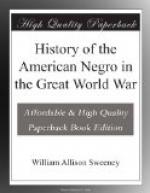In connection with the artillery training an interesting fact developed. It had been charged that Negroes could not develop into artilleryman. A strong prejudice against inducting them into that branch of the service had always existed in the army. It was especially affirmed that the Negro did not possess the mathematical ability necessary to qualify as an expert artillery officer. Nevertheless, out of a number of Negro aspirants, very small in comparison with the white men in training for officers’ commissions at the camp, five of the Negroes stood alongside their white brothers at the head of the class. The remainder were sprinkled down the line about in the same proportion and occupying the same relative positions as the whites. The prejudice against the Negro as an artilleryman was further and effectually dispelled in the record made by the 349th, 350th and 351st artillery regiments and their machine gun battalions in the 92nd division.
With the exception of the training camp for officers at Des Moines, Iowa, no important attempt was made to establish separate Negro training camps. In the draft quotas from each state were whites and blacks and all with few exceptions, were sent to the most convenient camp. Arrangements existed, however, at the different camps for the separate housing and training of the Negro troops. This was in line with the military policy of the Government, as well as in deference to the judgment of both white and black officers. It undoubtedly was necessary to separate the two races. Furthermore, as the military policy called for regiments, battalions and, divisions made up entirely of Negroes, it was proper to commence the organization at the training camps. Companies formed in this manner thus became homogeneous, accustomed to one another individually and to their officers.
The situation was different from the Spanish-American war, where Negro units, at least in one case, served in white regiments. Racial strife and rivalry were eliminated. The only rivalry that existed was the good-natured and healthy one of emulation between members of the same race. On the field of battle there was rivalry and emulation between the whites and blacks, but it was the rivalry of organizations and not of races. The whole was tempered by that splendid admiration and fellow-feeling which comes to men of all races when engaged as partners in danger or near death; in the defense and promotion of a great cause; the eternal verities of Justice and Humanity.
CHAPTER VIII
RECRUDESCENCE OF SOUTH’S INTOLERANCE
Confronted by racial PEEJUDICE—– splendid attitude of negro shamed it—kept out of navy—only one per cent of navy personnel negroes—modified marines contemplated—few have petty officers’ grades—separate ships proposed—negro efficiency in navy—material for “Black ships”—Navy opens door to negro mechanics.




